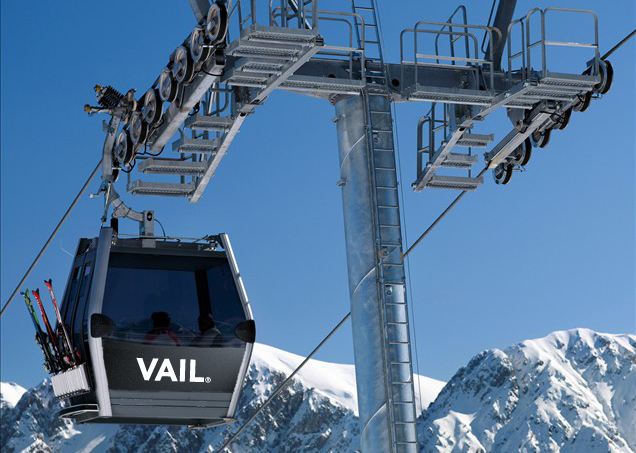Broomfield, CO – Financial results announced this week by ski resort operator Vail Resorts, Inc. show a decline in net income of more than 50 percent for fiscal year 2012. Still, investors seemed relieved by the news.
Net income attributable to Vail Resorts, Inc. of $16.5 million in fiscal 2012 declined from $34.5 million in fiscal 2011. Resort Reported EBITDA, which reflects the profitability of the company’s Mountain and Lodging segments, was $205.3 million for fiscal 2012 reflecting a decline of 7.5 percent, or $16.7 million, compared with the same period in the prior year. When adjusting for acquisition and litigation settlement related items in both current and prior year, fiscal 2012 Resort Reported EBITDA declined 3.8% from fiscal 2011.

Vail Resorts CEO Rob Katz nonetheless remained boldened by the company’s fourth quarter 2012 results also released this week, as well as its resiliency in dealing with the challenging winter of 2011-12. Capital improvement projects, including the installation of a new gondola at Vail Mountain with heated seats and Wi-Fi — one of the most expensive single capital improvement projects taking place at a North American ski resort — are continuing as planned.
“”I am very pleased with our fourth quarter and fiscal year results,” Katz asserted. “In the fourth quarter, our Resort Reported EBITDA was improved compared to the prior year, reflecting enhanced summer guest visitation. For the full fiscal year, I am very proud of our results given that the 2011-2012 ski season was the most challenging winter in the history of the United States ski industry and our performance demonstrated the resiliency of our business model. In particular, the strength of our growing season pass business and the comprehensive and differentiated experience we provide at our resorts stabilized our revenues, in the face of very challenging weather.”
Despite the drop, investors appeared relieved by the results as they were perhaps not as dismal as the market had suspected. Following the earnings release this week the company’s stock posted a new 52-week high of $59.46 during Tuesday trading.
Vail Resorts operates seven ski and snowboard resorts across the western U.S., including Vail Mountain, Beaver Creek, Breckenridge and Keystone in Colorado, as well as Northstar, Heavenly and Kirkwood in California. Both regions were hard hit by a lack of snowfall throughout most of last winter. At all locations, Vail Resorts is vertically integrated, where business activities encompass not only skiing, snowboarding and ancillary services, but also much of the available lodging, retail and dining. Summer visitation, critical to the company’s 2012 results, is expected to increase if a plan recently submitted to the U.S. Forest Service to enhance summer visitation is approved.
“In the Mountain Segment, net revenues actually increased 1.9 percent for fiscal 2012 despite total skier visits declining 12.1 percent compared to fiscal 2011,” Katz continued. “Several key factors contributed to our Mountain Segment results: the strength of season pass sales, which were up $15.8 million or 13.2% in revenue over a year ago; an increase in our effective ticket price, excluding season passes, of 9.3 percent; enhanced consumer spending resulting in double-digit growth in yield-per-skier visit in our ski school and dining operations and increased international visitation of approximately two. Each of these factors is a positive indicator as we look towards the upcoming season.”
Pre-season sales of 2012-13 Vail Resorts season passes also appear strong, likely supported by new season pass products as the company further develops its Lake Tahoe market. Through Sept. 23, pass sales were up approximately 17 percent in units and approximately 21 percent in sales dollars versus the comparable period in the prior year, adjusted as if Kirkwood were owned in both periods. Kirkwood was acquired by Vail Resorts last April. Based on historical patterns, approximately 60 percent of the company’s total season pass sales are made by Sept. 23.
Company-owned lodging was also impacted by last winter’s decline in skier visits, but Vail Resorts attempted to mitigate the impact of that decline by increasing its room rates and increasing the number of luxury room nights in the mix. Strong summer visitation, particularly at Grand Teton Lodge Company in Wyoming, also helped. As a result, the company’s lodging revenues actually increased 1.1 percent in fiscal 2012.
“Our balance sheet remains in a very strong position,” Katz concluded. “In fiscal 2012, we generated $185.4 million of operating cash flow and ended the fiscal year with $46.1 million of cash on hand. In the fourth quarter of fiscal 2012, in addition to paying out our quarterly dividend, we repurchased $22.5 million of stock at an average price of $46.78. As of July 31, 2012, Net Debt was 2.3 times trailing twelve months Total Reported EBITDA, and we had no borrowings under the revolver component of our senior credit facility. Additionally, we have virtually no principal payments due on debt until 2019.”

